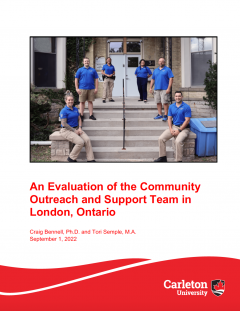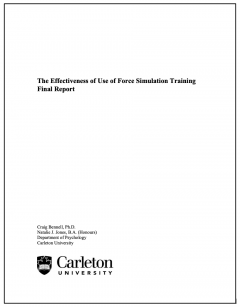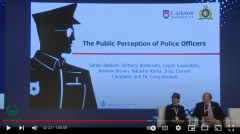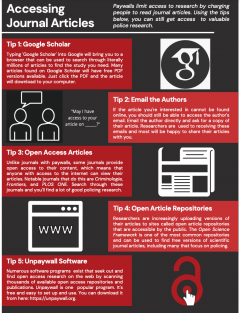A key goal of the lab is to have a positive impact on policing. This is difficult to do if we share our research solely through traditional outlets such as peer-reviewed journals and academic conferences. In an effort to get our research into the hands of key stakeholders, including police services, policy makers, and the public, we try to translate our research into formats that are more accessible. Below are some examples of these efforts. In the near future, we will be adding more attempts to this page, including many new videos and infographics. Check out Dr. Bennell’s Twitter as well for more information about our lab, and the Media page for news about our research.
APPLIED POLICE BRIEFINGS
Craig and Dr. Kirk Luther have started a major new initiative called Applied Police Briefings (APB). APB addresses the challenge police professionals face in accessing and understanding policing research. Our mission is to make published policing research accessible, free of charge, and easy to understand.
Key features of APB include:
- User-Friendly Access: An easy-to-navigate platform for all users
- Open Access: Free access to all APB materials
- Clarity in Communication: Research briefs are free of technical and statistical jargon
- Concise Content: Briefs are kept succinct for quick and easy reading
- Reputable Sources: We use reputable, peer-reviewed research that addresses key policing questions
- Diverse Perspectives: Incorporating a variety of research methodologies and viewpoints
APB is dedicated to empowering police professionals with research insights to enhance their work.
You can review each of the previous issues of APB by clicking on the images below.
PODCASTS
Craig and Kirk Luther talk to Deputy Chief (ret.) Jim Dudley about Applied Police Briefings on the Police Matters podcast. Check it out by clicking on the image.
Craig talks to Chris Butler from Raptor Protection and Safety Services about his recently co-authored paper “Safety of vascular neck restraint applied by law enforcement officers” as part of the Trainer’s Bullpen podcast. Sign up to view the video here.

Bryce Jenkins talks to Chris Butler from Raptor Protection and Safety Services about his recently co-authored paper “Primed to use force? A systematic review examining the relationship between tactical experience and use of force” as part of the Trainer’s Bullpen podcast. Sign up to view the video here.

Simon Baldwin talks to Chris Butler from Raptor Protection and Safety Services about his recently co-authored paper “A reasonable officer: Examining the relationships among stress, training, and performance in a highly realistic lethal force scenario” as part of the Trainer’s Bullpen podcast. Sign up to view the video here.

CONFERENCE VIDEOS
Baldwin, S., Blaskovits, B., Ewanation, L., Brown, B., Korva, N., Campbell, D., & Bennell, C. (2019, March). The public perception of police officers. Paper presented at the 12th International Symposium for Best Police Practice, Dubai, UAE. [see Simon Baldwin’s presentation from 40:22 to 1:00:20 by clicking the image below]
EDUCATIONAL VIDEOS
Zack Lair created this excellent educational video about his recent paper, The importance of context: Re-examining the ‘deployments’ of SWAT teams in Canada, which he co-authored with Bryce Jenkins, Tori Semple, and myself. Check it out by clicking on the image.
INFOGRAPHICS
For police officers who are having difficulty accessing published research, check out this new research brief written for the Canadian Association of Chiefs of Police by clicking here. You can also find a related infographic (created by Noah Bennell) by clicking the image below.
PUBLICLY AVAILABLE REPORTS
Bennell, C., & Semple, T. (2002). An evaluation of the Community Outreach and Support Team in London, Ontario. Report prepared for the Canadian Mental Health Association Thames Valley Addiction and Mental Health Services, St. Joseph’s Healthcare London, Middlesex-London Paramedic Service, and the London Police Service. [PDF]

Huey, L., Andersen, J., Bennell, C., Campbell, M., Koziarski, J., Vaughan, A. (2021). Caught in the currents: Evaluating the evidence for common downstream police response interventions in calls involving persons with mental illness. Report prepared for the Royal Society of Canada. [PDF]

Semple, T., & Bennell, C. (2017). Injuries and deaths proximate to oleoresin capsicum (OC) deployment: A literature review. Report prepared for Correctional Service Canada. [PDF]

Bennell, C., & Jones, N.J. (2004). The effectiveness of use-of-force simulation training: Final report. Report prepared for the Canadian Police Research Centre. [PDF]

MAGAZINE/NEWSLETTER ARTICLES
Baldwin, S. (2022). Stress, training, and the objective reasonableness standard. Force Science News. [PDF]
Duxbury, L., & Bennell, C. (2019). Changing the conversation from cost to value. PAO (Police Association of Ontario) Magazine, 72, 10-12. [PDF]
Snook, B., Bennell, C., Taylor, P.J., House, J., MacDonald, S., & Luther, K. (2012). A critique of the violent crime linkage analysis system. Blue Line, April, 14-16. [PDF]
Hogan, J., Bennell, C., Taylor, A. (2011). The challenges of moving into management: A survey of Canadian police officers. Part 1. Blue Line, January, 18-20. [PDF]
Hogan, J., Bennell, C., Taylor, A. (2011). The challenges of moving into management: What Canadian police really say about moving into management. Part 2. Blue Line, February, 22-25. [PDF]
Snook, B., Gendreau, P., Bennell, C., & Taylor, P.J. (2008). Criminal profiling: Granfalloons and gobbledygook. Skeptic, 14, 36-41. [PDF]
Bennell, C. (2006). A call for the use of statistical prediction rules in police investigations. Crime Scene, January, 6-7. [PDF]
Taylor, A., Corey, S., & Bennell, C. (2006). The temporal consistency of crime scene behaviours in serial sexual homicide. Crime Scene, September, 28. [PDF]
Bennell, C., Snook, B., & Taylor, P.J. (2005). Geographic profiling – The debate continues: Ten problems with the Rossmo and Filer defence of computer profiling. Blue Line, October, 34-36. [PDF]
Corey, S., Bennell, C., Taylor, P.J., & Snook, B. (2005). The effect of task complexity on predictive accuracy in a geographic profiling task. Crime Scene, September, 14-16. [PDF]
Snook, B., Taylor, P.J., & Bennell, C. (2005). Man versus machine: The case of geographic profiling. Blue Line, April, 56. [PDF]
Snook, B., Taylor, P.J., & Bennell, C. (2003). Brunswik’s influence on geographic profiling research. The Brunswik Society Newsletter, October, 28-29. [PDF]
Snook, B., Taylor, P.J., & Bennell, C. (2003). Using CrimeStat for geographic profiling. In N. Levine and Associates, CrimeStat Spatial Statistics Program (p. 379). Washington, DC: National Institute of Justice. [PDF]






